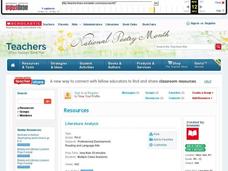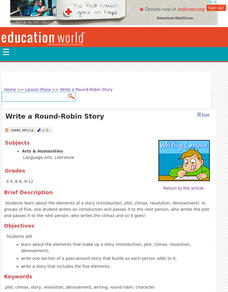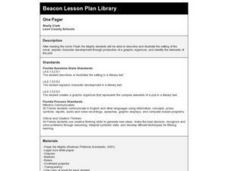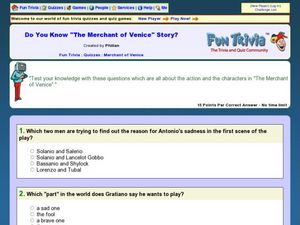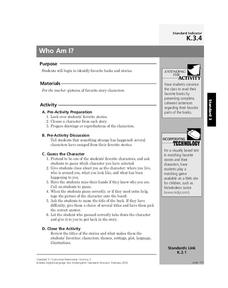Curated OER
Reading Practice: Boris the Brainiest Baby
Boris is the smartest baby around! Beginning readers can use this short story excerpt to practice reading comprehension and fiction elements. They read the story and then discuss what they think he will do next. Scholars create an...
Curated OER
Silly Story Starters
Fifth graders brainstorm some ideas for each of the columns. As they call them out, write some on the sticky notes until each sticky note is used for each column They stay in the same groups; have each group draw one sticky note from...
Curated OER
Literature Analysis
Students explore the concept of literature analysis. In this literature analysis lesson, students discuss the story elements of a book. Students also discover how to pair share and use each other as a resource.
Curated OER
PowerPoint Short Story Report
Students make a Microsoft PowerPoint report from a short story read in class. They summarize and paraphrase a short story identifying the six story elements: characters, setting, plot, conflict, solution, tone/mood.
Curated OER
Philanthropy in A Christmas Carol
Middle schoolers explore philanthropy in literature. In this cross curriculum literacy and character development lesson, students read A Christmas Carol by Charles Dickens and note charitable acts described in the story. Middle schoolers...
Curated OER
Characterization
In this story elements worksheet, students complete a graphic organizer about characterization. Students describe the character's words, personality, appearance and reputation. There are four bubbles within the graphic organizer to...
Curated OER
A Fine Feathered Flock
Young scholars role play different situations. In this respect lesson, students read Mr. Lincoln's Way, identify the story elements and answer comprehension questions. Young scholars discuss how they can always treat others with respect...
Curated OER
Crafty Literature Projects to Lure Language Arts Learners
Recognize National Arts and Crafts Month with language arts project ideas to inspire creative learning.
Curated OER
Setting the Story: Techniques for Creating a Realistic Setting
“It was a dark and stormy night.” Thus begins the 1830's novel Paul Clifford and, of course, all of Snoopy’s novels! Encourage young writers to craft settings for their stories that go beyond Edward Bulwer-Lytton’s often-mocked phrase...
David Elementary
Structural Elements of Drama
The world may indeed be a stage, and players certainly need to know drama vocabulary. This list of 16 terms (and their definitions) often found in scripts will prompt actors to perform their role.
Curated OER
Write a Round-Robin Story
Students discover the elements of a story (introduction, plot, climax, resolution, denouement). In groups of five, one student writes an introduction and passes it to the next person, who writes the plot and passes it to the next person,...
Hawaiʻi State Department of Education
Story Design
Stories contain very specific elements; plot, characters, and key events. Learners use pantomime to retell a key event from the beginning, middle, and end of a story. They discuss setting and character as each group discusses and then...
Curated OER
Deciding Theme
Read aloud to your class the fable "The Lion and the Mouse" as you explore characters' choices and the effects they have on a story. Apply what is discussed to finding a theme of the chapter "Not Giving Up" from The Wizard of Oz.
Curated OER
Poetic Elements
Poetry is all about sound and rhythm. The sound of the words, the rhythm of the lines, and the emotional atmosphere created by these elements and the literary devices poets use, compress whole stories into a few stanzas. The specialized...
Freeology
Annotations Bookmark
In general, pupils are not allowed to write in school-issued books; however, they can write on a bookmark that you provide! Kids can take notes on the setting, characters, themes, and connections as they read a short story or novel.
Curated OER
Teaching Peace through Literature and Song
Negative effects of bullying come to light through listening to the book Thank You, Mr. Falker by Patricia Polacco. Class members identify philanthropic acts portrayed in the story and make illustrations to connect them to their own...
Curated OER
Characterization
In this characterization worksheet, students fill out a graphic organizer chart. Students write the character's name in the center and an example of each of the 4 characterization methods by the author. There are instructions to help.
Curated OER
Interpreting Dramatic Works
Action! Delve into character development in the play Fences by August Wilson, setting the stage for learners to analyze character nuances. Thespians choose a scene from the script, responding with a written account of the character's...
Curated OER
Life Size Characters
Sixth graders analyze character traits and create a life size character outline. In this character analysis lesson, 6th graders analyze character traits of a character using character webs and poems. Students then create a life size...
Curated OER
One Pager
Learners read the novel, Freak the Mighty and describe and illustrate the setting. They create a graphic organizer that demonstrates the major plot elements and character development.
Curated OER
Do You Know The Merchant of Venice Story: Fun Trivia Quiz
This multiple-choice quiz tests pupils' ability to recall information about plot and character, making it a possible resource to check for understanding or completion of reading. Immediate feedback and scoring make Fun Trivia Quizzes a...
Curated OER
Story Literary Elements Worksheet
In this literary elements worksheet, students read selected short stories and then respond to 5 short answer questions based on the stories.
Curated OER
One Story, Many Tales
Students compare and contrast various versions of the fairytale Cinderella. In this folktale lesson, students read The Korean Cinderella and The Egyptian Cinderella and analyze the differences between the two stories. Students identify...
Curated OER
Who Am I?
Students read a story together then choose a favorite character to portray. In this inference lesson, students pretend to be one of the characters in the story, they prepare drawings or actions then present them to the class. Students...




